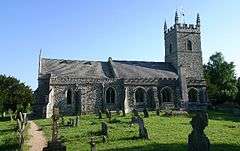Horringer
| Horringer | |
 St Leonard's Church, Horringer |
|
 Horringer |
|
| Population | 890 (2005)[1] 1,055 (2011)[2] |
|---|---|
| District | St Edmundsbury |
| Shire county | Suffolk |
| Region | East |
| Country | England |
| Sovereign state | United Kingdom |
| Post town | Bury St Edmunds |
| Postcode district | IP29 |
| Police | Suffolk |
| Fire | Suffolk |
| Ambulance | East of England |
| EU Parliament | East of England |
Coordinates: 52°13′23″N 0°40′23″E / 52.223°N 0.673°E
Horringer is a village and civil parish in the St Edmundsbury district of Suffolk in eastern England. It lies on the A143 about two miles south-west of Bury St Edmunds. The population in 2011 was 1055.[1]
Heritage
Horringer was earlier known as Horningsheath. The school kept this spelling until after the Second World War.[3]
The village includes Ickworth house, a Neoclassical country house which is the seat of the 8th Marquess of Bristol and run by the National Trust.
Notable persons
The religious controversialist and cleric Thomas Rogers (c. 1553–1616) was the rector of St Leonards, Horringer, from 1581 until his death.[4]
Horringer was the birthplace of Elizabeth Cavendish, Duchess of Devonshire, born Elizabeth Christiana Hervey on 13 May 1759. She became a notable society hostess and patron of the arts.[5] Her father was Frederick Hervey, 4th Earl of Bristol, who later became Bishop of Cloyne (1767–1768) and Bishop of Derry (1768–1803). He was a believer in equality among religions.[6]
The remains of Victor Hervey, 6th Marquess of Bristol (1915–1985) were brought home from Menton, France, by his son in 2010, for a funeral at Horringer before burial at Ickworth.[7]
Cricketer Melmoth Hall (1811–1885) was born here.[8]
Demography
According to the Office for National Statistics, at the time of the United Kingdom Census 2001, Horringer had a population of 901 with 397 households.[9] increasing to a population of 1,055 at the 2011 Census.
Population change
| Population growth in Horringer from 1801 to 1891 | ||||||||||
|---|---|---|---|---|---|---|---|---|---|---|
| Year | 1801 | 1811 | 1821 | 1831 | 1841 | 1851 | 1881 | 1891 | ||
| Population | 543 | 523 | 539 | 586 | 597 | 670 | 662 | 599 | ||
| Source: A Vision of Britain Through Time[10] | ||||||||||
| Population growth in Horringer from 1901 to 2001 | |||||||||||
|---|---|---|---|---|---|---|---|---|---|---|---|
| Year | 1901 | 1911 | 1921 | 1931 | 1951 | 1961 | 2001 | 2011 | |||
| Population | 525 | 552 | 569 | 545 | 465 | 468 | 901 | 1,055 | |||
| Source: A Vision of Britain Through Time[10] | |||||||||||
Location grid
 |
Little Saxham | Westley | Bury St Edmunds |  |
| Ickworth | |
Nowton | ||
| ||||
| | ||||
| Chevington | Whepstead | Hawstead |
References
- 1 2 Estimates of Total Population of Areas in Suffolk Suffolk County Council
- ↑ "Civil Parish population 2011". Neighbourhood Statistics. Office for National Statistics. Retrieved 23 August 2016.
- ↑ Horringer Village. Retrieved 31 March 2014.
- ↑ ODNB: John Craig, "Rogers, Thomas (c.1553–1616)" Retrieved 30 March 2014, pay-walled
- ↑ ODNB: Amanda Foreman, "Cavendish , Elizabeth Christiana, duchess of Devonshire (1757–1824)" Retrieved 30 March 2014, pay-walled.
- ↑ ODNB: Gerard O'Brien, "Hervey, Frederick Augustus, fourth earl of Bristol (1730–1803)" Retrieved 30 March 2014, pay-walled.
- ↑ Haden-Guest, Anthony. "The end of the peer", The Observer, January 22, 2006. Accessed May 17, 2008.
- ↑ "Melmoth Hall". ESPN Cricinfo. Retrieved 29 January 2015.
- ↑ "Suffolk County Council - 2001 Census Profiles" (PDF). Retrieved 2011-02-22.
- 1 2 "A Vision of Britain Through Time". University of Portsmouth & others. Retrieved 2011-02-22.
External links
| Wikimedia Commons has media related to Horringer. |